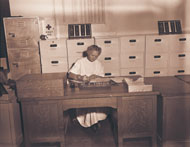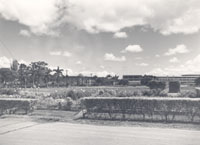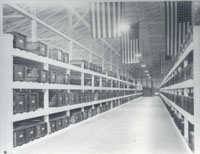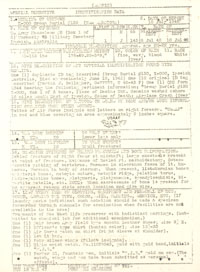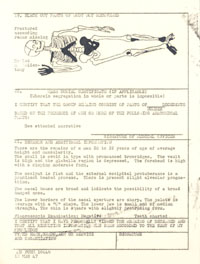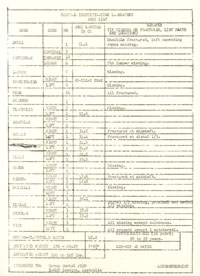In Her Words
“Operations at Central Identification Laboratory” by Mildred Trotter, 1949
Mildred Trotter wrote this report summarizing her work at the Central Identification Laboratory of the American Graves Registration Service in 1948-49. Trotter spent 14 months as the anthropologist at Schofield Barracks on Oahu, helping to identify the remains of American servicemen killed and buried in the Pacific Zone during World War II. This paper describes the process of identifying skeletal remains from both single and group burials, though Trotter later learned that this report had been “shelved.” In the spring of 1949, she was asked to identify the commingled remains from the U.S.S. Arizona in Pearl Harbor. Trotter felt that segregation and individual identification of these remains was not possible; all the remains recovered from the Arizona were eventually interred in a common grave in the National Cemetery located in Punchbowl Crater.
OPERATIONS AT CENTRAL IDENTIFICATION LABORATORY, A.G.R.S
By Mildred Trotter
World War II took the lives of approximately 350,000 Americans. Our government has undertaken to return the recoverable remains (approximately 300,000) to American soil, should such be the desire of the next of kin. If the next of kin wishes interment overseas, the remains are interred in American-owned cemeteries in Holland, England, France, Italy, Luxembourg, Tunis, the Philippine Islands, Hawaiian Islands, Alaska or Puerto Rico. When a remains is exhumed and positively identified the next of kin is notified and given a choice of disposition; either burial in a private cemetery or in a National Cemetery.
The responsibility of this entire undertaking has been assigned to the Department of Army under the direction of the Quartermaster General and is termed American Graves Registration Service.
There is involved: first, disinterment and delivery to a “Processing Station.” These stations are located at Marbo on Saipan (one of the Marshall Islands), Manila in the Philippines, Japan and on Oahu for the Pacific Zone; at Fontainbleau (formerly at Strasbourg) and Carenton, France, and at Margraten near Maastricht in the Netherlands for the European Command; in Naples and Leghorn, Italy for the Mediterranean area and also, one in Cartage, North Africa. In addition, there is a mobile unit with headquarters just outside Paris.
At the “Processing Station,” the identification of all remains is checked. More than 94 percent of the recovered remains have been positively identified. It must be emphasized that once official identification of a deceased has been made there can be absolutely no doubt as to the authenticity of that identification. In other words, remains are either positively identified or they are not – there is no tentative identification of remains which are about to be delivered to the next of kin.
If the remains is an identified one, the second step is to prepare it for burial in a “final type” casket, a beautiful (steel) one, with a bronzed finish which is hermetically sealed.
If the remains is an unidentified one, it is sent to the laboratory of the appropriate processing station for an anthropological examination. This involves the recording of as many physical data as are available, or as can be determined or estimated such as: race, sex, height, weight, age, a dental chart and occasionally even finger prints, as well as a reproduction of the identification tag (“dog”), serial or laundry marks on clothing, jewelry and numbered items of issued equipment.
At Schofield Barracks, two large connected buildings serve as mausoleums (numbers 1 and 2) where caskets from all parts of the Pacific are arranged in their original cemetery associations waiting examination and identification. Flags overhang the caskets and guards are on duty at all times. Other storage mausoleum areas are located at Wahiawa and Pearl Harbor; (the administrative Offices are at Fort Shafter).
A section of Mausoleum 1 serves as a visitors’ lounge. This section is partitioned off into several small rooms where visitors may withdraw to spend time with the casketed remains or with the urn (if the body has been cremated), or where a funeral service may be held.
Central Identification Laboratory, established in the fall of 1947, located in Mausoleum 2 at Schofield, is a light, airy and sanitary working area (a square room covering approximately 2000 sq. ft.) resembling in many respects a dissection room in a medical school. It is equipped with metal-covered tables (high and therefore comfortable for standing) and stools, fluorescent lights, sinks, a sterilizer, individual storage lockers, and operating room gowns. The wash-room is equipped with showers.
Certain group burials have been brought to us which were very large. In order to segregate the remains of this type of burial, it is essential to have all the remains “laid-out” at the same time. Thus, it was expedient to extend the laboratory until, now in addition, it covers approximately 9,000 more square feet. In the extension area, the tables are low and comfortable for sitting height. In adjacent rooms are offices for the army personnel and stenographers, a supply room, a fluoroscopic room, a photographic room and a coffee room.
The C.I.L. staff consists of the Army supervisors (one major and one captain), an anthropologist, licensed embalmers (there were 23 when I arrived last June), two dental technicians, a chemist, a photographer, an X-ray technician, several stenographers and typists, enough clerks for each pair of embalmers to have one available most of the time and a great number of laborers. The laboratory and both mausoleums are kept immaculate.
More then 99% of the remains which are brought to the C.I.L. are skeletal. In general, it may be said that they come under three categories: a single burial, a small group burial (2 – 15) and a large group burial (the largest at C.I.L. has been 434 which were recoverable remains from 2 common graves on the Island of Formosa).
First, I shall describe what is involved in processing a single burial. The unknown is assigned to a pair of embalmers who lay the remains out on a sheet-covered table, the bones in anatomical arrangement. It may be necessary to brush the bones or sometimes even to wash them in order that definite criteria may be seen. At no time, however, are any soft parts, which might remain on the bones, removed. If the bones are broken, pieces are matched and held together with scotch tape, if possible. The remaining contents of the temporary casket are carefully examined (often fluoroscoped) for missing teeth, personal effects, I.D. tags, etc. The embalmers have been trained by the anthropologist, who is the roving consultant in the laboratory. (I haven’t been able to get away from the student-teacher relationship.)
The bones are examined for evidence of healed fractures, mastoidectomy, pathology (arthritic lipping of vertebrae and of long bones), variations, such as torus palatinus, supracondyloid process, retroverted tibial heads, saber-shaped tibiae, third trochanter of the femur, squatting facets, wormian or sutural bones of the skull, perforation of olecranon fossa of sternum, etc.
The bones are then appraised for race: Pure racial strains are relatively easy and the skull gives the best evidence. Where the race is not pure, the various characters must be weighed.
The Negro has a very long, narrow cranium with a markedly sloping forehead and a low vault in contrast to the Mongoloid with a rounded outline, erect forehead and rather high vault. The pattern of the sutures gives a clue – the more tortuous suggesting White and the relatively simple Mongoloid or Negroid. The White skull is probably the most variable but stands between the two extremes. The browridges are best marked on the White skull. The nasal opening is wide and its lower margin “troughed” or “guttered” in the Negroid, narrow and dull and somewhat guttered in the Mongoloid, and sharp in the White. Prognathism or protrusion of the mouth parts, which are large with a receding chin indicates a Negro, whereas large but relatively straight mouth parts and chin are Mongoloid and for the White, the mouth parts are smaller, frequently with a pinched effect and with a protruding chin. The palate is indicative of race because of size and height. The teeth also show racial characteristics; large and complete sets with little sign of caries indicate the Negroid, large and rather square showing extreme wear, the Mongoloid – and in both, but more often in Mongoloid, the lingual surface of the incisors may be shovel-shaped, i.e., there is a ridge or piling up around a concavity on the lingual surface which if the tooth were held in the horizontal position is sufficiently marked to hold a drop or two of water. The general impression of a Mongoloid skull is large, smooth and rounded; of a Negroid, massive, smooth, elongate and a somewhat constricted oval, and of the White, any combination of these characters but, in general, somewhat rugged, i.e., better marked browridges, areas of muscle attachments, larger mastoid processes and external occipital protuberance, etc.
Certain characteristics of the post-cranial skeleton may be looked for in settling the question of race, although not many characters have been studied for all three races: the length of the tibia in relation to femur is greater in the Negro than White, likewise the radius to the humerus, and the upper limbs to the lower limbs. The lateral third of the clavicle is flatter and smoother in the Negro than White (based on work done by Dr. R. J. Terry). Often there are present on the tibia and talus of the Mongoloid “squatting” facets, less often in the Negroid and only rarely in the White.
Although I have not seen a record of it, I have been impressed with the fact that the distal extremity (or 1/3) of the shaft of the humerus bows somewhat anteriorly; the cubital area is neither concave nor straight but rather convex. This may be seen in the living.
Sex differentiation is not too difficult and almost never needed. Since I have been at Schofield, no female remains has been brought to the laboratory. The characteristics of the pelvis are (according to Dr. W.M. Krogman) 98% accurate. The true pelvis of the female is not only relatively but actually broader than the male, the subpubic angle more rounded, the greater sciatic notch, rounded and shallow, whereas in the male it is deep and narrow. The sacrum, the symphysis, the iliac wings, etc. all have sex characters. In addition, the bones of the entire skeleton of the female are smaller and smoother with less well-marked muscle attachment areas, and almost no browridges.
Age:
The older the individual the more difficult it becomes to determine age from the skeleton. The age distribution of those in military service was as follows: 10% between 18 and 20 years, 60% were between 20 and 30 years, 27% between 30 and 40 years and only 3% over 40 years of age. Un-united epiphyses constitute the best guide up to the early or middle twenties. The proximal epiphysis of the humerus is the last one of the long bones to unite and may be expected to be tight at 20-1/2 years. The clavicular epiphysis at the medial extremity may become tight anywhere from 25 to 28 years.
The spheno-occipital synchondnosis has become a synostosis by 20 years of age. Suture closure begins at 22 years in the sagittal suture in the region of the parietal foramina; in another two years at the lower portions of the coronal suture and shortly thereafter in the lambdoid. During the late twenties closure progresses rapidly and then slows up so that by the late thirties or early forties it is complete. In the progressive stage the degree of closure ecto- and endo-cranially may not agree. It is believed that the evidence on the endocranial surface is more accurate, so we therefore make the examination with the aid of a little flashlight through the foramen magnum.
The topography of the symphyseal surface of the Pubic bone has been studied very carefully from the standpoint of age by the late T. Wingate Todd of Western Reserve. The margins become well demarcated by the late twenties and the articular surface quite flat by the early thirties, following which there is a roughening of a less defined pattern than in the early twenties.
Stature estimates:
The height estimate is derived from either tables or formulae in conjunction with the length of the long bones. In 1888, Rollet, a Frenchman, made the original tables based on measurements of 100 of his countrymen, 50 men and 50 women. Later, re-evaluations of Rollet’s original measurements were presented by Monauvrier and by Pearson. The only other work on this subject available to us was done by Breitinger in 1938 on Scandinavians and Krogman has suggested that possibly Breitinger’s formulae will give greater accuracy for tall Americans.
The variations in results of these four methods applied to a given individual may be as much as five inches. It is hoped that measurements of long bones of known remains may be accumulated in sufficient quantity for study and that better methods of height estimates of Americans may be secured. Because of the many different stocks in our country producing both extremes and all graduations between in stature such a study would require availability of the physical data records taken at the time of induction into the service of the man whose identified remains have been measured.
Weight:
The estimated weight of the individual is taken from tables set up by Dr. Helen Pryor of California in conjunction with height, age and greatest width between the outer borders of the iliac crests. The spread for a given set of criteria is approximately 20 lbs.
Group Burials:
The approach to the segregation of individuals whose remains have become intermingled due, for example, to the type of accident at the time of death (plane crash), is first, a survey of bones present. In most cases certain bones, especially some vertebrae, are missing so that a continuous skeletal arrangement can not be set up. First, duplication of bones is looked for in order to determine the number of individuals represented. (I recall one case in which it was said that the partial remains of five men were present. Examination produced nine left talus bones). Then the bones are separated according to articulation, size, color, morphology and/or texture. When there are several individuals who are approximately the same age it is difficult to know how to associate the skull with the post-cranial remains, particularly, if the vertebral column is not complete. But, if “Form 371” is available which is a record of the dental chart, the dates of birth and death, and the height and weight at the time of induction the remains can usually be segregated with security.
Our report for an individual is submitted on a standard form consisting of four pages. On page one are given pertinent data of the cemetery; a summary of the race, age, weight, height and color of hair; a description of any official identification found with the remains; whether the body was burned or mangled; evidence of healed fractures and bone malformations, and a list of clothing and other personal effects in as much detail as possible.
On page two is the dental chart on which are indicated locations of teeth missing after death, teeth extracted before death, drift as the result of an adjacent extraction, cavities, and type of extent of fillings.
On page three is an outline of the skeleton on which the parts missing from the remains are blacked out; a brief description of the probable appearance of the man; the estimated height according to three authorities and a note concerning the fluoroscopic examination and tooth chart.
On page four is the bone list which corresponds with the skeleton outline picture, and, in addition, are recorded the measurements of the individual bones.
These papers are prepared in triplicate, of which two are sent to a Board of Review who studies them with the purpose of matching the record with the data known of the individual. In addition to the physical data there are usually available both cemetery and casualty listings and flight listings (missing air crew reports) of the number and names in a particular tank crew. If the two lists of physical evidence are sufficiently uniform, the papers are sent on to Washington for scrutiny by another Board of Review before the identification is considered to be certain.
Related Links:
Return to Speeches, Essays & Narratives (In Her Words)
Return to In Her Words
Back to Top

